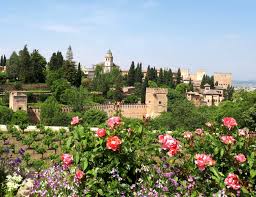The Alhambra Gardens in Granada, Spain, represent one of the most enchanting landscapes in the world. Nestled within the historic Alhambra palace complex, these gardens are a symbol of Moorish sophistication and architectural genius. They captivate visitors with their intricate designs, delicate fountains, lush vegetation, and historical depth. Whether you're a lover of history, architecture, or simply serene beauty, the Alhambra Gardens in Granada offer a mesmerizing experience unlike any other.
The Origins of Alhambra Gardens, Granada
The story of the Alhambra Gardens Granada dates back to the 13th century, during the Nasrid dynasty. The rulers of this Islamic kingdom, who governed much of Andalusia, sought to create a palace complex that would be both a fortress and a haven of peace. The gardens were designed as essential parts of this vision—spaces meant not only for leisure but for spiritual reflection, embodying paradise on earth.
The Role of Water in Garden Design
One of the most striking elements of the Alhambra Gardens, Granada, is the use of water. Moorish architects and gardeners understood the symbolic and practical importance of water in a hot, arid climate. The gardens feature flowing channels, reflective pools, and intricate fountains that not only cool the environment but also create a calming auditory and visual experience. Water becomes an artistic element, often arranged symmetrically to mirror the perfection of the heavens.
Generalife: The Jewel of the Gardens
Among the many sections of the Alhambra Gardens Granada, the Generalife stands out as the most celebrated. The name itself translates to "Architect's Garden" or "Garden of Paradise." Constructed as a summer palace for the Nasrid kings, the Generalife is separated from the main Alhambra complex, situated on the Cerro del Sol (Hill of the Sun). Its gardens are renowned for their tiered layout, beautiful patios, and the famous Patio de la Acequia, where a central water channel is lined with arching jets and fragrant flora.
Islamic Influence in Landscape Architecture
The Alhambra Gardens Granada are a testament to the brilliance of Islamic garden design. Influenced by Persian and Arabic traditions, these gardens emphasize symmetry, balance, and harmony with nature. Trees are strategically planted to offer shade and bear fruit, while flower beds bloom in geometric arrangements. The result is a carefully curated environment that reflects divine order and natural beauty, embodying the very essence of Islamic aesthetics.
Seasonal Beauty and Botanical Richness
The changing seasons bring different charms to the Alhambra Gardens Granada. In spring, visitors are welcomed by blooming roses, jasmine, and orange blossoms that fill the air with sweet scents. Summer brings lush greenery and the refreshing mist of the fountains. Autumn paints the landscape in golden hues, while even winter offers a quiet, contemplative beauty. The gardens host a wide variety of plants, including cypress trees, myrtle, pomegranate, and even ancient olive trees that have stood for centuries.
Historical Significance and Preservation
The Alhambra Gardens Granada are not just a feast for the senses—they are also of immense historical significance. After the Christian Reconquest in 1492, the gardens underwent various changes under the rule of the Catholic Monarchs and later Spanish rulers. While certain Christian elements were introduced, efforts have been made over the centuries to preserve the gardens’ original Moorish identity. Today, they are maintained by skilled horticulturists and historians who ensure that this cultural heritage remains intact for future generations.
The Gardens as a Reflection of Philosophy and Culture
The philosophical undertones embedded in the Alhambra Gardens Granada cannot be overlooked. Moorish rulers believed that gardens were reflections of paradise—safe havens where humans could connect with nature, contemplate life, and engage in spiritual reflection. The symmetrical layouts, flowing water, and botanical variety all contribute to a meditative experience. Walking through these gardens is not merely an aesthetic journey; it's a passage through time and thought.
Tourism and Visitor Experience
Each year, millions of tourists from around the world come to witness the breathtaking beauty of the Alhambra Gardens Granada. Walking tours are available, and many are guided by experts who share fascinating stories of the Nasrid rulers, the architectural elements, and the historical transitions. Whether it's the thrill of discovering ancient pathways or the joy of watching sunlight play over the water channels, the gardens provide an immersive experience that captivates visitors of all ages.
Photography and Artistic Inspiration
The Alhambra Gardens in Granada are a favorite subject for photographers, painters, and poets alike. The combination of light, shadow, water, and flora creates dynamic scenes that change throughout the day and across seasons. Artists often seek inspiration here, capturing not just the physical elements but also the sense of peace and grandeur that the gardens evoke. It’s no wonder that this space has influenced countless works of art over the centuries, both in Spain and internationally.
A Must-Visit Destination in Granada
If you're planning a trip to southern Spain, the Alhambra Gardens in Granada should be at the top of your list. Beyond the historical and architectural significance, the gardens offer a deeply personal experience—one that touches the soul and ignites the imagination. They represent the harmonious blend of culture, nature, and human creativity at its finest. As you stroll through the shaded paths and listen to the gentle murmur of water, you will understand why these gardens are considered one of the crown jewels of Andalusian heritage.
Conclusion
The Alhambra Gardens in Granada are far more than just a beautiful space; they are a living monument to the confluence of history, culture, spirituality, and art. Every step taken within these lush corridors echoes the footsteps of ancient kings, poets, and visionaries who once found solace and inspiration here. Whether experienced in the vibrant light of day or under the quiet stars of a Granada night, the gardens continue to enchant and educate, making them a timeless destination that resonates with all who enter.





Comments